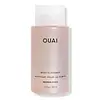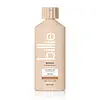What's inside
What's inside
 Key Ingredients
Key Ingredients

 Benefits
Benefits

 Concerns
Concerns

 Ingredients Side-by-side
Ingredients Side-by-side

Water
Skin ConditioningSodium C14-16 Olefin Sulfonate
CleansingGlycerin
HumectantCocamidopropyl Betaine
CleansingSodium Methyl Cocoyl Taurate
CleansingPEG-40 Hydrogenated Castor Oil
EmulsifyingPEG-150 Pentaerythrityl Tetrastearate
EmulsifyingAcrylates Copolymer
Simmondsia Chinensis Seed Oil
EmollientRosa Canina Fruit Oil
EmollientLactobacillus Ferment
Skin ConditioningSodium Hyaluronate
HumectantSodium Hydroxide
BufferingBenzophenone-4
UV AbsorberCocamide Mipa
EmulsifyingDisodium EDTA
Hydroxyacetophenone
AntioxidantPEG-6 Caprylic/Capric Glycerides
EmulsifyingPolyquaternium-7
Polysorbate 20
EmulsifyingTocopherol
AntioxidantEthylhexylglycerin
Skin ConditioningSodium Chloride
MaskingSodium Benzoate
MaskingPhenoxyethanol
PreservativeParfum
MaskingCitronellol
PerfumingLinalool
PerfumingCI 60730
Cosmetic ColorantWater, Sodium C14-16 Olefin Sulfonate, Glycerin, Cocamidopropyl Betaine, Sodium Methyl Cocoyl Taurate, PEG-40 Hydrogenated Castor Oil, PEG-150 Pentaerythrityl Tetrastearate, Acrylates Copolymer, Simmondsia Chinensis Seed Oil, Rosa Canina Fruit Oil, Lactobacillus Ferment, Sodium Hyaluronate, Sodium Hydroxide, Benzophenone-4, Cocamide Mipa, Disodium EDTA, Hydroxyacetophenone, PEG-6 Caprylic/Capric Glycerides, Polyquaternium-7, Polysorbate 20, Tocopherol, Ethylhexylglycerin, Sodium Chloride, Sodium Benzoate, Phenoxyethanol, Parfum, Citronellol, Linalool, CI 60730
Water
Skin ConditioningSodium C14-16 Olefin Sulfonate
CleansingSodium Coco-Sulfate
CleansingCocamidopropyl Betaine
CleansingGlycerin
HumectantCocamide Mipa
EmulsifyingSodium Chloride
MaskingPEG-7 Glyceryl Cocoate
EmulsifyingParfum
MaskingSodium Hyaluronate
HumectantHydrolyzed Wheat Protein
Skin ConditioningHydrolyzed Wheat Starch
Skin ConditioningTocopherol
AntioxidantDehydroacetic Acid
PreservativeDisodium EDTA
Benzyl Alcohol
PerfumingHydroxypropyl Guar Hydroxypropyltrimonium Chloride
Citric Acid
BufferingPhenoxyethanol
PreservativeHexyl Cinnamal
PerfumingWater, Sodium C14-16 Olefin Sulfonate, Sodium Coco-Sulfate, Cocamidopropyl Betaine, Glycerin, Cocamide Mipa, Sodium Chloride, PEG-7 Glyceryl Cocoate, Parfum, Sodium Hyaluronate, Hydrolyzed Wheat Protein, Hydrolyzed Wheat Starch, Tocopherol, Dehydroacetic Acid, Disodium EDTA, Benzyl Alcohol, Hydroxypropyl Guar Hydroxypropyltrimonium Chloride, Citric Acid, Phenoxyethanol, Hexyl Cinnamal
 Reviews
Reviews

Ingredients Explained
These ingredients are found in both products.
Ingredients higher up in an ingredient list are typically present in a larger amount.
We don't have a description for Cocamide Mipa yet.
Cocamidopropyl Betaine is a fatty acid created by mixing similar compounds in coconut oil and dimethylaminopropylamine, a compound with two amino groups.
This ingredient is a surfactant and cleanser. It helps gather the dirt, pollutants, and other impurities in your skin to be washed away. It also helps thicken a product and make the texture more creamy.
Being created from coconut oil means Cocamidopropyl Betaine is hydrating for the skin.
While Cocamidopropyl Betaine was believed to be an allergen, a study from 2012 disproved this. It found two compounds in unpure Cocamidopropyl Betaine to be the irritants: aminoamide and 3-dimethylaminopropylamine. High-grade and pure Cocamidopropyl Betaine did not induce allergic reactions during this study.
Learn more about Cocamidopropyl BetaineDisodium EDTA plays a role in making products more stable by aiding other preservatives.
It is a chelating agent, meaning it neutralizes metal ions that may be found in a product.
Disodium EDTA is a salt of edetic acid and is found to be safe in cosmetic ingredients.
Learn more about Disodium EDTAGlycerin is already naturally found in your skin. It helps moisturize and protect your skin.
A study from 2016 found glycerin to be more effective as a humectant than AHAs and hyaluronic acid.
As a humectant, it helps the skin stay hydrated by pulling moisture to your skin. The low molecular weight of glycerin allows it to pull moisture into the deeper layers of your skin.
Hydrated skin improves your skin barrier; Your skin barrier helps protect against irritants and bacteria.
Glycerin has also been found to have antimicrobial and antiviral properties. Due to these properties, glycerin is often used in wound and burn treatments.
In cosmetics, glycerin is usually derived from plants such as soybean or palm. However, it can also be sourced from animals, such as tallow or animal fat.
This ingredient is organic, colorless, odorless, and non-toxic.
Glycerin is the name for this ingredient in American English. British English uses Glycerol/Glycerine.
Learn more about GlycerinParfum is a catch-all term for an ingredient or more that is used to give a scent to products.
Also called "fragrance", this ingredient can be a blend of hundreds of chemicals or plant oils. This means every product with "fragrance" or "parfum" in the ingredients list is a different mixture.
For instance, Habanolide is a proprietary trade name for a specific aroma chemical. When used as a fragrance ingredient in cosmetics, most aroma chemicals fall under the broad labeling category of “FRAGRANCE” or “PARFUM” according to EU and US regulations.
The term 'parfum' or 'fragrance' is not regulated in many countries. In many cases, it is up to the brand to define this term.
For instance, many brands choose to label themselves as "fragrance-free" because they are not using synthetic fragrances. However, their products may still contain ingredients such as essential oils that are considered a fragrance by INCI standards.
One example is Calendula flower extract. Calendula is an essential oil that still imparts a scent or 'fragrance'.
Depending on the blend, the ingredients in the mixture can cause allergies and sensitivities on the skin. Some ingredients that are known EU allergens include linalool and citronellol.
Parfum can also be used to mask or cover an unpleasant scent.
The bottom line is: not all fragrances/parfum/ingredients are created equally. If you are worried about fragrances, we recommend taking a closer look at an ingredient. And of course, we always recommend speaking with a professional.
Learn more about ParfumPhenoxyethanol is a preservative that has germicide, antimicrobial, and aromatic properties. Studies show that phenoxyethanol can prevent microbial growth. By itself, it has a scent that is similar to that of a rose.
It's often used in formulations along with Caprylyl Glycol to preserve the shelf life of products.
Sodium C14-16 Olefin Sulfonate is a cleansing agent made from a mixture of long chain sulfonate salts. It can also help produce foam.
This ingredient may be drying. We recommend speaking with a professional if you have concerns.
Chances are, you eat sodium chloride every day. Sodium Chloride is also known as table salt.
This ingredient has many purposes in skincare: thickener, emulsifier, and exfoliator.
You'll most likely find this ingredient in cleansers where it is used to create a gel-like texture. As an emulsifier, it also prevents ingredients from separating.
There is much debate on whether this ingredient is comedogenic. The short answer - comedogenic ratings don't tell the whole story. Learn more about comegodenic ratings here.
The concensus about this ingredient causing acne seems to be divided. Research is needed to understand if this ingredient does cause acne.
Scrubs may use salt as the primary exfoliating ingredient.
Learn more about Sodium ChlorideSodium Hyaluronate is hyaluronic acid's salt form. It is commonly derived from the sodium salt of hyaluronic acid.
Like hyaluronic acid, it is great at holding water and acts as a humectant. This makes it a great skin hydrating ingredient.
Sodium Hyaluronate is naturally occurring in our bodies and is mostly found in eye fluid and joints.
These are some other common types of Hyaluronic Acid:
Learn more about Sodium HyaluronateTocopherol (also known as Vitamin E) is a common antioxidant used to help protect the skin from free-radicals and strengthen the skin barrier. It's also fat soluble - this means our skin is great at absorbing it.
Vitamin E also helps keep your natural skin lipids healthy. Your lipid skin barrier naturally consists of lipids, ceramides, and fatty acids. Vitamin E offers extra protection for your skin’s lipid barrier, keeping your skin healthy and nourished.
Another benefit is a bit of UV protection. Vitamin E helps reduce the damage caused by UVB rays. (It should not replace your sunscreen). Combining it with Vitamin C can decrease sunburned cells and hyperpigmentation after UV exposure.
You might have noticed Vitamin E + C often paired together. This is because it is great at stabilizing Vitamin C. Using the two together helps increase the effectiveness of both ingredients.
There are often claims that Vitamin E can reduce/prevent scarring, but these claims haven't been confirmed by scientific research.
Learn more about TocopherolWater. It's the most common cosmetic ingredient of all. You'll usually see it at the top of ingredient lists, meaning that it makes up the largest part of the product.
So why is it so popular? Water most often acts as a solvent - this means that it helps dissolve other ingredients into the formulation.
You'll also recognize water as that liquid we all need to stay alive. If you see this, drink a glass of water. Stay hydrated!
Learn more about Water